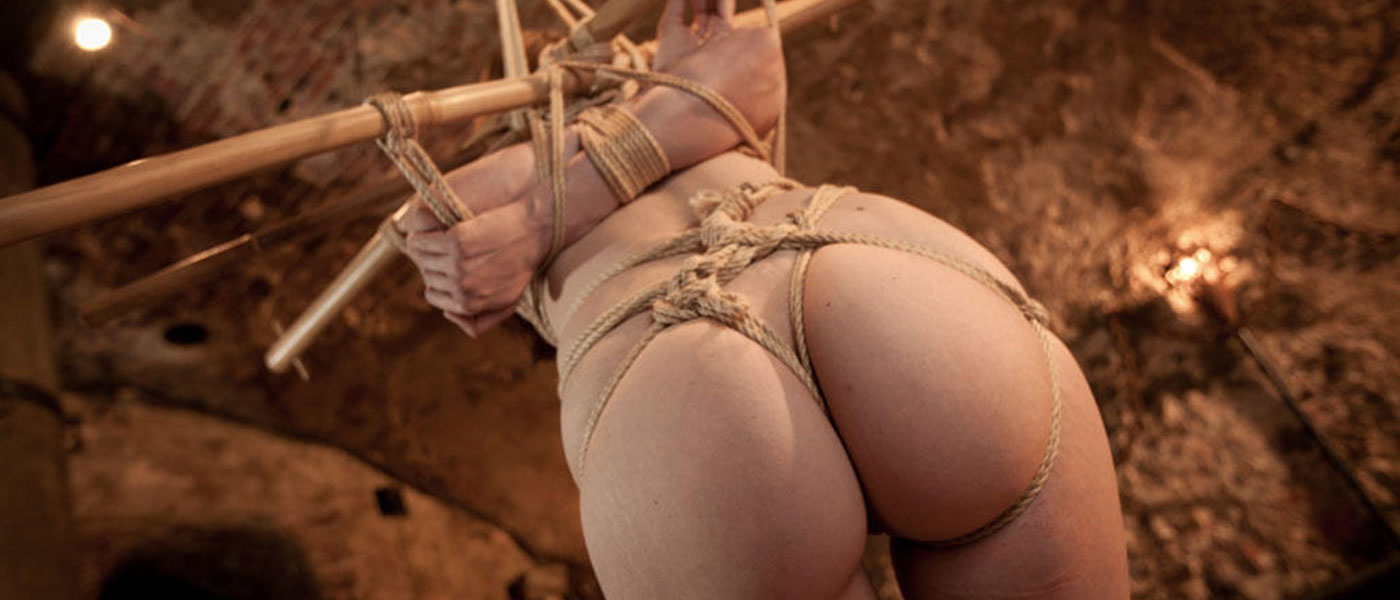Japanese Art of Shibari
Shibari, also known as Japanese rope bondage or "kinbaku," represents a contemporary manifestation of rope bondage with its origins rooted in Japan. The term "shibari" directly translates to "tying," while "kinbaku" signifies "tight binding." These terms are often used interchangeably to describe the same type of activity. In essence, Shibari revolves around the art of restraining someone using ropes. It can take on various forms: at times, it incorporates sexual intimacy as couples bind each other into specific positions, while on other occasions, the enjoyment is derived purely from the act of tying itself. Historically, however, Shibari has served as more than a physical act of bondage; it has functioned as a meditative, relaxation-inducing, and trust-building practice between two individuals.

Japanese rope bondage serves as a means of expressing emotions and connecting with our partners. Much like musicians, artists, dancers, or performers, Shibari practitioners recognize the distinction between mechanically following a predetermined set of steps and infusing their actions with genuine emotions.
Through Shibari, individuals have the opportunity to establish a profound connection with their partner, embarking on a shared journey to explore their desires and one another. Along the way, they make deliberate choices about the tone they wish to set—whether it's an atmosphere of sensuality and passion, intensity and challenge, light-heartedness and fun, or any other mood that resonates with them. Shibari thus becomes a powerful medium for forging emotional bonds and expressing shared feelings within a consensual and creative context.

In contemporary Japan, Shibari is embraced by consenting adults in the realm of their private sexual experiences. Additionally, it finds a place in stage performances featured in kink-themed establishments and, naturally, within the domain of adult entertainment. Beyond Japan, Shibari is gaining traction in Western cultures as well, with kink and fetish clubs in the United Kingdom and mainland Europe warmly incorporating Shibari into their repertoire of activities and play.Shibari often finds its place within the broader context of BDSM (Bondage, Discipline, Dominance, Submission, Sadism, and Masochism). While Shibari alone may not necessarily be BDSM, it can be a significant component of BDSM scenes and dynamics.
For some, Shibari represents a form of erotic bondage within the BDSM framework. The ropes become tools for restraint, control, and exploration of power dynamics. Trust and communication between participants are essential, ensuring that the experience remains safe, consensual, and satisfying for all involved.
Shibari, like many practices, has its own set of commonly used terms and phrases to facilitate communication and understanding among practitioners. These terms play an essential role in ensuring a safe and enjoyable experience:
Rigger/Rope Top: The individual responsible for performing the intricate tying and knotwork is known as the "Rigger" or "Rope Top." They take on the role of creating the beautiful and sensual Shibari patterns.

Rope Bottom/Bunny: The person who is being bound and subjected to the artistic and sensual rope work is referred to as the "Rope Bottom" or sometimes affectionately as the "Bunny."
Floor Tie: "Floor Tie" describes a style of Shibari where all rope work is executed on the ground or floor. This form of Shibari can be both visually captivating and physically stimulating.
Suspension: An advanced and often exhilarating form of Shibari is "Suspension." It involves the art of lifting the body off the floor entirely, using ropes alone. Suspension Shibari requires a high level of skill, safety precautions, and trust between the participants.
Self-tie: "Self-tie" is a practice in which an individual ties themselves, assuming both the roles of Rigger and Rope Bottom. Self-tying can be a deeply personal and exploratory experience.
Throughout their rope journey, individuals often encounter fellow enthusiasts with a wide array of motivations and approaches to their enjoyment of Shibari. Some are drawn to the sheer aesthetic beauty, relishing the sight of themselves or their partners gracefully bound. For others, the allure lies in the act of submitting to a dominant partner, embracing the thrill of surrender, while some find their fulfillment in taking the lead and dominating a submissive partner, savoring the exhilaration of control.
Trust becomes a central theme for some, as they are fulfilled by the profound level of trust their partner places in them, especially concerning their safety. The irresistible allure of passion and arousal that accompanies the feeling of being unable to resist their lover's advances drives others. Deeper connections and intimacy are sought by those who view Shibari as a means to forge profound emotional bonds.
The creative challenge of adapting to different partners intrigues some, while others view fear and pain as natural sensations that can be sensually enjoyed. For some, the appeal lies in the exploration of taboos within a consensual context, creating a thrilling excuse to indulge. The notion of being bound is found to be relaxing by some, offering a respite from the stresses of life such as deadlines and exams. Others view the act of being bound in rope as liberating and even spiritual, while some cherish the experience of being tied alongside their partners, fostering a shared connection and enjoyment of Shibari. In this diverse tapestry of motivations and experiences, Shibari offers a deeply personal and multifaceted journey for its practitioners.

Entering the world of Shibari, also known as Japanese rope bondage, demands a thoughtful and well-prepared approach. It's an art form and practice that involves intricate knotting and rope work, and, as with any activity that includes physical restraints, safety should always be a paramount concern.
Before embarking on a Shibari journey, it is essential to invest time in acquiring knowledge and skills. This often begins with reading and learning about the art. Many resources, both online and in print, provide valuable insights into the history, techniques, and safety considerations of Shibari. Exploring these resources not only imparts a foundational understanding but also fosters a sense of respect for the art and its traditions.
Moreover, clear and open communication is the linchpin of Shibari. Partners must engage in candid conversations about their desires, boundaries, and expectations before the ropes even touch the skin. Consent is fundamental, and everyone involved should have a shared understanding of their roles and intentions. Establishing safe words or signals is crucial to ensure that either party can communicate discomfort, the need for adjustment, or a desire to halt the session at any point.
Engaging in bondage and other kinks can indeed pose risks, and rushing into activities beyond one's skill level can lead to serious accidents and harm for the rope bottom. These dangers encompass asphyxiation, fall injuries, circulation loss, nerve damage, dislocation, and, in extreme cases, even death. Even with proper training, these risks remain, but fortunately, there are workshops available that provide valuable insights into the technical aspects of bondage, thereby enhancing safety.
However, it is essential to recognize that physical dangers are not the sole concerns within this realm. The potential for mental and emotional harm is also a critical consideration. Instances of sexual assault, psychological trauma, consent violations, breaches of trust, and emotional neglect can all result from a poorly managed bondage session. To address these aspects, there are workshops and resources aimed at helping individuals mitigate these potential risks.
By prioritizing safety, collaborating effectively, and not treating it as an afterthought, participants can establish a foundation that affords them greater freedom and peace of mind to fully enjoy their bondage sessions while minimizing both physical and emotional risks.
As beginners take their initial steps into the world of Shibari, it is advisable to start with cotton rope. This choice is popular due to its softer texture, which is gentle on the skin and minimizes the risk of abrasions or discomfort. Additionally, cotton ropes are easier to clean, enhancing the overall hygiene of the Shibari experience.
Another practical tip for novices is to begin with shorter ropes. Shorter lengths are more manageable and reduce the chances of tangling during the intricate tying process. Long ropes can be cumbersome to handle, leading to frustration for the person performing the ties and potential boredom for the one awaiting the experience. Shorter ropes not only simplify the learning curve but also allow for a more focused and enjoyable exploration of Shibari.
Shibari is an art form that requires careful preparation, education, and open communication. It is a journey of trust, creativity, and sensuality, where the safety and comfort of all participants should always be the top priority.
To ensure a safe and consensual Shibari session, the use of "safe words" or "safe signals" is paramount. These words or signals act as a clear means of communication between the participants. Safe words or signals are used to indicate when either party wishes to alter or stop the current activities. While some people opt for the widely recognized traffic light system—green for continue, yellow for approaching limits, and red for immediate cessation—it is highly encouraged for participants to establish safe words or signals that resonate most with their own needs and comfort levels. The choice of safe words or signals should reflect the unique dynamics and boundaries of the individuals involved, fostering an environment of trust and respect in their Shibari practice.
Despite the artistic and sensual merits of Shibari in the adult industry, it is not without challenges and controversies. Critics argue that its portrayal in adult content can sometimes commodify the art form, reducing it to a mere fetish for profit. Ethical concerns may arise when consent or boundaries are not respected, or when the artistry is overshadowed by explicit content.
Additionally, the cultural appropriation of Shibari by those who do not fully understand its historical and philosophical roots is a contentious issue. Cultural sensitivity and respect for the origins of the practice should be paramount, especially within the adult entertainment context.
